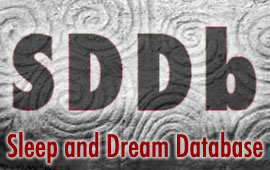 If someone presented you with two sets of dreams, one of most recent dreams and one of highly memorable dreams, you could predict with a high degree of confidence which type of dream was in which set, based only on word usage frequencies.
If someone presented you with two sets of dreams, one of most recent dreams and one of highly memorable dreams, you could predict with a high degree of confidence which type of dream was in which set, based only on word usage frequencies.
The set with more references to flying, air, family, animals, fantastic beings, Christianity, and death is more likely to consist of highly memorable dreams.
This is a testable hypothesis that emerges out of a comparison of the SDDb baselines for most recent dreams (MRDs) and highly memorable dreams (MemDs), available here. To be clear, it’s a prediction of probability, not certainty. Some highly memorable dreams have none of these elements, while some most recent dreams have several of them. But according to the SDDb baselines, it is the statistical tendency of highly memorable dreams to contain significantly more of these elements than we generally find in most recent dreams.
Whether or not this hypothesis has any practical application, it adds new evidence in support of the theoretical claim that dreams are meaningfully structured not just for the individual dreamer but also in relation to each other. There really are different types of dreams, and their differences can be expressed in increasingly precise terms.
Other researchers such as Harry Hunt and Don Kuiken have proposed psychological models to account for different types of dreams (what Hunt calls “the multiplicity of dreams”). I am not yet at the point with the SDDb baselines to feel comfortable engaging directly with their approaches, but that is definitely a long-term goal.
At this stage I want to look more closely at the higher-frequency MemD elements and try to understand what they might contribute to the dreams’ long-term impact on waking awareness.
Flying: Not all dream references to flying involve magical powers–some relate to the flight of birds, or flying on airplanes, or floating in water, or time “flying” by. But many of the references are indeed about people flying magically, and I think it makes good sense that overall, MemDs have significantly more flying references than MRDs. I would be surprised if it were otherwise, based on the recurrence of magical flying dreams through cross-cultural history. Genuine flying dreams tend to be quite vivid and realistic, and it’s reasonable to assume that such unusually stimulating sensations would make a lasting impact on waking awareness.
Air: Some of the air references occur in flying dreams, but in most MemDs the air references appear in different contexts: the dreamer is struggling to breathe, or facing a tornado, or noticing the wind blowing. I don’t know about dreams of wind, but certainly with dreams of tornados and potential suffocation the memorability of the experience is likely to be very high. A tornado is the most powerfully destructive form of air in nature, and suffocation is a perennial threat to human life, perhaps especially in sleep for people who snore or have apnea.
Family: References to family members appear often in MRDs; they appear even more often in MemDs. I think it’s fair to say that most people’s strongest emotional relationships (both positive and negative) are with family members. Thus it makes sense that their appearance in a dream correlates with high memorability. Looking in more detail at the word search results, references to parents (e.g., mother, father, mom, dad) tend to be the highest, suggesting that dreams in which the individual is cast as a child or in a child’s role are more likely to be memorable.
Animals: Based on any of several different theories (psychoanalytic, developmental, evolutionary), it could be expected that MemDs would have a higher proportion of animals than MRDs. Psychoanalytically, animals symbolize powerful instinctual energies. Developmentally, animals appear more often in children’s than in adults’ dreams, and MemDs are often recalled from early in childhood. In evolutionary terms, animals in dreams may reflect ancestral threats that we are innately primed to notice and remember.
Fantastic Beings: This category by definition includes characters who are not “real,” so their appearance in dreams naturally arouses some degree of heightened awareness and emotional impact. Many of them are perceived as extremely frightening and dangerous to the life of the dreamer. I was surprised by the SDDb baseline results that the MemDs do not have more fear-related emotions than the MRDs, but perhaps what makes some MemDs different is the supernatural source of the fear. There is a connection to be made here with the notion of “minimally counterintuitive supernatural agents” as used in the cognitive science of religion–dreaming is a rich experiential source of people’s religious and spiritual beliefs about such beings.
Christianity: Many references to Christianity in both MRDs and MemDs are relatively trivial references to Christmas, or mild oaths, or a person’s name. But more often in the MemDs there are direct references to interactions with Jesus, battles with demons, visiting heaven, and worshipping in church. In a majority-Christian country like the U.S., where all the SDDb baseline participants reside, this seems like an expectable result. Insofar as Christianity, like most religions, is concerned with deep questions of morality, suffering, and faith, any dream that refers to religious teachings is likely to register more memorably in the dreamer’s awareness.
Death: Whether considered in religious or secular terms, death surely counts as a major existential concern of human life. Dreaming itself has long been mythologically associated with death, and cultural traditions all over the world have stories about dreams as a portal to the afterlife. In MemDs the theme of death takes many forms: other characters dying or being killed right in front of the dreamer, dead relatives appearing as if alive (i.e., visitation dreams), and, more rarely, the dreamer him or herself dying. When the prospect of mortality arises in a dream, it’s not surprising that the individual takes notice and remembers.
What do these seven higher-frequency MemD elements have in common?
For one thing, several of them involve “counter-factuals,” i.e., phenomena that are literally impossible in ordinary waking life. Magically flying in the air, encountering fantastic beings, seeing people who are dead appear as if alive–these are strikingly anomalous experiences that stand out from ordinary life and make a big impression on memory.
Secondly, several of the MemD themes involve dire threats to the individual’s life and well-being. Dreams of death, demons, monsters, wild animals, suffocation, and tornados naturally arouse a host of psychological and physiological responses that can literally seize the dreamer’s attention and hold it long after waking.
Thirdly, a few MemD themes relate closely to the prominent themes of children’s dreams generally, with more animals and higher family references. As I noted earlier, the SDDb baseline for MemDs includes numerous childhood-era dreams reported by children and adults, so it is definitely skewed toward children’s dream content. That means the differences between MRDs and MemDs could be explained as artifacts of the differences between adults and children. I grant there will be a large degree of overlap between highly memorable dreams and children’s dreams–precisely because the most memorable dreams people often recall are dreams from childhood.
Not all children’s dreams are big dreams–but many big dreams are dreams that have been remembered from childhood.
 Here are the recent posts I have written for Psychology Today, going back to the middle of last summer. Although each one is written as a stand-alone discussion of a special topic in dreaming, I now realize they also form a series of interrelated texts, like the chapters of a book I didn’t consciously know I was writing….
Here are the recent posts I have written for Psychology Today, going back to the middle of last summer. Although each one is written as a stand-alone discussion of a special topic in dreaming, I now realize they also form a series of interrelated texts, like the chapters of a book I didn’t consciously know I was writing….
 People make many strange and unexpected discoveries when they begin exploring their dreams. Of these discoveries, perhaps the most surprising is an uncanny encounter with images, themes, and energies that can best be described as spiritual or religious. It’s one thing to realize you have selfish desires or aggressive instincts; it’s another thing entirely to become aware of your existence as a spiritual being. Yet that is where dreams seem to have an innate tendency to lead us—straight into the deepest questions of human life, questions we find at the heart of most of the world’s religious traditions.
People make many strange and unexpected discoveries when they begin exploring their dreams. Of these discoveries, perhaps the most surprising is an uncanny encounter with images, themes, and energies that can best be described as spiritual or religious. It’s one thing to realize you have selfish desires or aggressive instincts; it’s another thing entirely to become aware of your existence as a spiritual being. Yet that is where dreams seem to have an innate tendency to lead us—straight into the deepest questions of human life, questions we find at the heart of most of the world’s religious traditions.
 The latest series to be uploaded into the Sleep and Dream Database (
The latest series to be uploaded into the Sleep and Dream Database (

